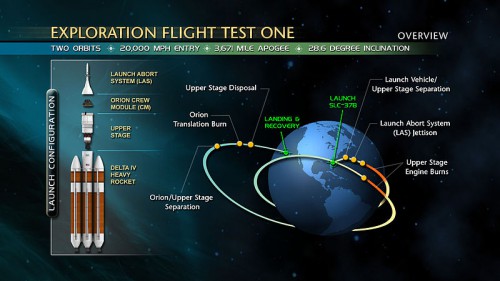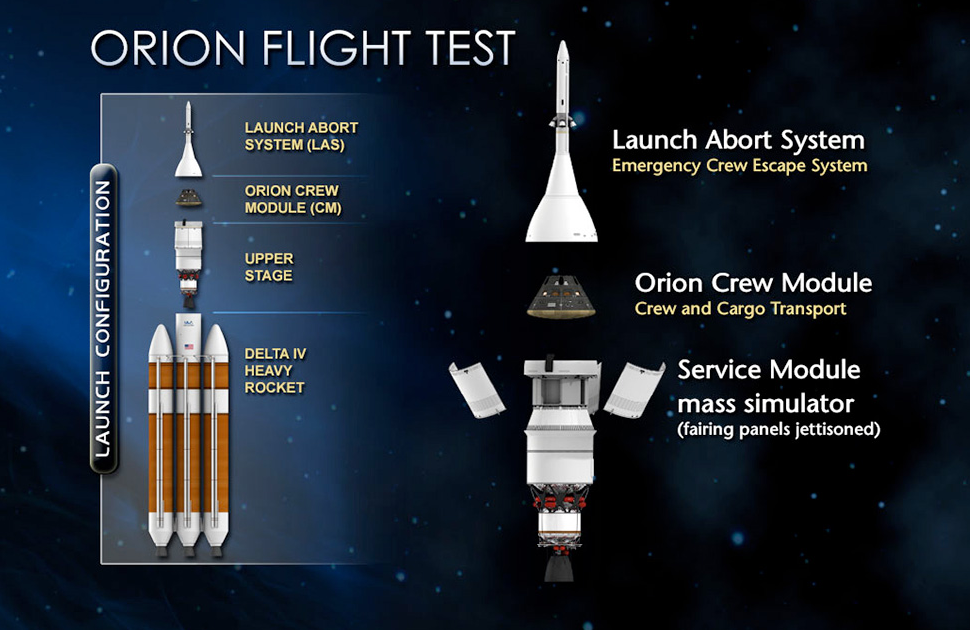Orion EFT-1: On the shoulders of giants
With the global imagination fired by stories of the European Space Agency’s Philae and Rosetta spacecraft earlier this month, NASA is little more than a week away from launching the next chapter in human space flight history.
On 4th December a Delta IV rocket will carry the country’s new Orion capsule further into space than any manned mission since December 1972. There won’t be the death-defying rendezvous with a speeding comet that captured public attention with Philae, but this mission – branded Exploration Flight Test 1 (EFT-1 for short) – heralds an even greater dawn of exploration.
With a flight time of just over 4 hours, you can easily sit and watch as history unfolds next week. But what will you need to know? Here’s your step-by-step guide to Orion’s baptism of fire…
L-06:00:00
Six hours before launch, the Orion spacecraft will be powered up and the Delta IV rocket that will carry it into orbit will begin taking on the liquid oxygen and hydrogen fuel it needs for lift-off.
12:05GMT
The launch ‘window’ opens for Orion to begin the historic flight at 12:05 GMT. This window remains open until 14:44 GMT, so if there’s no launch by then, expect a ‘scrub’ as the mission is rescheduled. But if we get action, the spacecraft could leave Cape Canaveral’s Launch Complex 37 any time in this period.
00:03:30
3.5 minutes into the flight, the shuttle-style strap-on rocket boosters will fall away from the rest of the spacecraft having exhausted their fuel supplies, but given Orion a vital helping hand on the first leg of its journey.
00:04:00
4 minutes since leaving the pad, the first stage of the Delta IV rocket – built by Boeing – also completes its job and follows the boosters back to Earth after being jettisoned. With the now dead extra weight shed, the second stage ignites and propels Orion past the 5,000 mph mark as it continues the journey to space.
00:06:15
A little over the 6 minute mark, the protective shield that shrouds Orion and preserves the capsule from the violent forces sustained during ascent is useless, as is the abort system designed to pluck the capsule from danger in the event the Delta IV rocket explodes; the spacecraft is now beyond the grip of Earth’s atmosphere and with no wind resistance to damage the capsule, the redundant shroud is jettisoned.
00:17:00
In the time it took you to brew a cuppa and maybe use the loo, Orion has reached orbit. It’s now speeding overhead at 18,000mph and heading higher…
01:57:11
Approaching the 2 hour point of the mission, Orion will re-light the second stage engine of its Delta IV rocket and boost the high point – the apogee – of its orbit out to 3,600 miles.
03:00:00
Orion coasts up to it apogee and is now at its furthest distance from Earth. No spacecraft capable of carrying humans has been this far from home since the Apollo 17 lunar landing in December 1972.
03:23:41
Just before the 3.5 hour mark of the flight and somewehere east of the Philippines, Orion jettisons the second stage of the Delta IV that ferried it to orbit and the service module that has, until now, provided all the power and disposables for the crew capsule.
03:57:00
Orion makes a 180 degree turn to ensure the ablative heat shield protecting the crew on the return to Earth is presented to the atmosphere as the ship approaches entry interface.
04:13:41
Entry interface. The leading edge of Orion bites into the thin layers of air in the upper atmosphere. As the density of air increases, the friction and temperature begins to rise on the outside of the spacecraft. At speeds of up to 20,000mph, temperatures are approaching 2,200′ centigrade – 60-70% that of a mission returning at ballistic speeds from the Moon.
04:20:22
The critical moment when all could go very publicly wrong. Having survived the inferno of re-entry, parachute deployment begins with the release of 2 ‘drogue’ chutes that slow the capsule’s fall. These are shortly followed by the 3 main ‘chutes that will deliver Orion safely to the surface of the waiting Pacific Ocean at a gentle 20 mph.
04:24:46
Just under 4.5 hours after leaving the Cape, Orion splashes down and completes the historic journey having survived the extremes of space – hopefully!
If you intend to follow what promises to be the most significant flight in decades – likely your lifetime – tune in to NASA TV here on Thursday 4th December. Be a part of the first chapter in mankind’s second space age!

